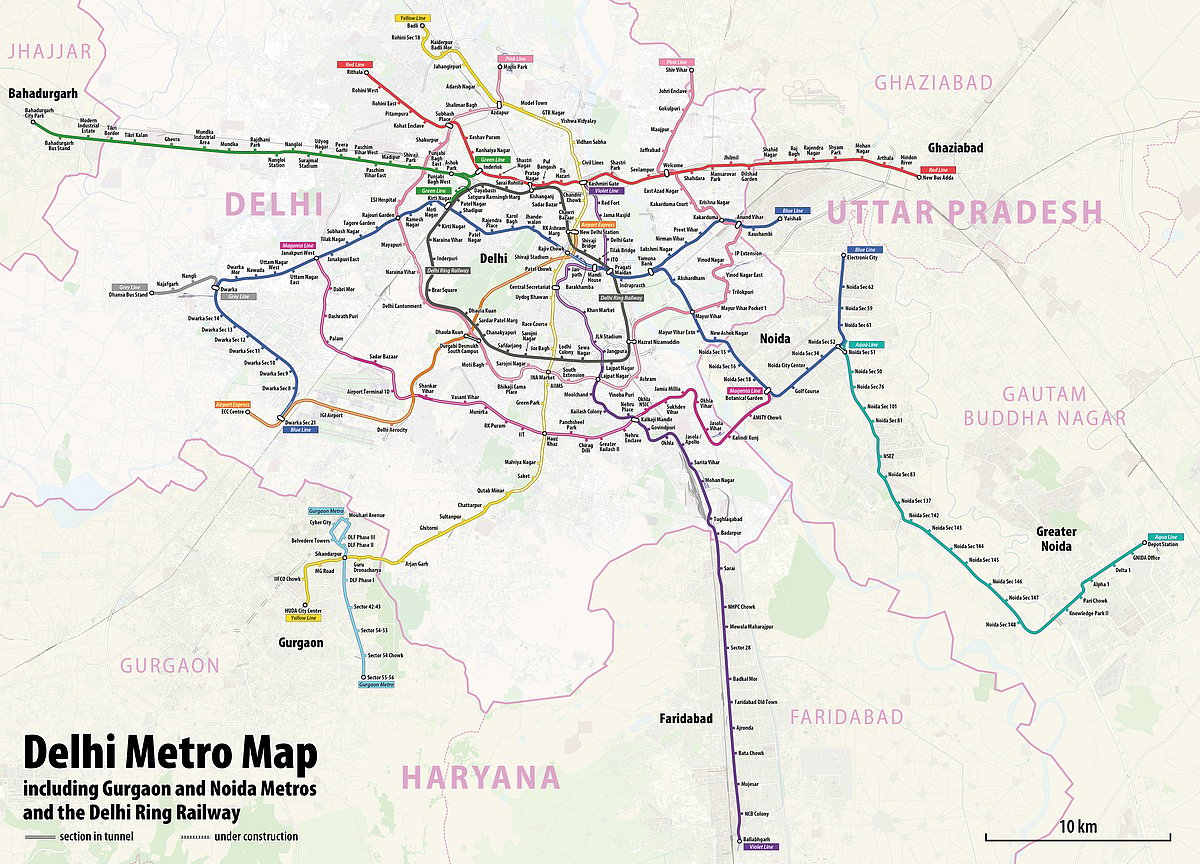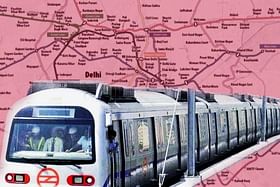Snapshot
-
More than being a mode of transportation, Delhi Metro was an infrastructural marvel everyone wanted to experience.
Around 2011, a few of the author’s friends in Delhi University had figured out an innovative use of the metro network. To dodge the long power cuts and the consequential summer heat in their hostels, they used to hop on to the metro, travel until the last station on the line, and then return.
Accompanied by their assignments or curriculum books or even intoxicating literature, the metro, with all its comfort and cleanliness, was a safe haven, for at least three hours, from the summer struggles of the national capital. All at a miniscule cost.
However, they were not the first ones to imagine the metro in that manner.
Between 2002, when the metro was first inaugurated, and 2010, when the network was beginning to settle, millions must have purchased a ride token on their visit to Delhi, only to experience the phenomenon that was beginning to engulf the region with more than three crore people, or 2.5 per cent of India’s population.
More than being a mode of transportation, it was an infrastructural marvel everyone wanted to experience.
India’s Greatest Infrastructure Story Is Underway
On 25 December 2002, when Atal Bihari Vajpayee was the Prime Minister, when internet was a luxury for most urban Indians and an unknown entity for rural Indians, when even Orkut was not released, and before MS Dhoni made his international debut, the Delhi Metro opened its first line, the Red Line, between Tis Hazari, near the District and Sessions Court, and Shahdara, a crowded stop on the Delhi-Ghaziabad border.
Six stations, 8-odd kilometers, and India’s greatest urban infrastructure story was underway.
Twenty years later, the Delhi Metro Rail Network, bureaucratically abbreviated as the DMRC, has twelve lines, each labeled as a different colour, spans across 390-odd kilometers, and 286 stations.
It encompasses a greater part of Noida, Greater Noida, Faridabad, Ghaziabad, Bahadurgarh, and a small fraction of Gurugram. From a daily ridership of 124,00-odd in 2004-2005, it was catering to more than 2.5 million people before the pandemic hit.
On 30 July 2019, it registered 5.16 million trips. The annual ridership was 1.79 billion for 2019.
As much as Delhi, the satellite towns around the capital have also benefited, especially economically, from the metro. In 2009, the Noida link on the Blue Line, until Noida City Center, and in 2010, Delhi-Gurugram’s Yellow Line, ending at HUDA City Centre became operational.
In the same year, the Delhi-Ghaziabad link, a branch of the Blue Line, was opened to the public. In 2011, a link on the Violet Line was made operational until the Delhi-Faridabad border, and from there on, the networks kept expanding, year after year, phase after phase.
The magnitude of the expansion can be gauged by the upgradation that has been in the works for more than a decade on some lines.
For instance, the Red Line, first inaugurated in December 2002, was last upgraded in March 2019. The Yellow Line, made operational in December 2004, was last upgraded in 2015. Similarly, the Blue Line, inaugurated in 2005, was last upgraded in 2019.
Interestingly, more expansion is being proposed for both Blue and Red Line, and for lines connecting other satellite towns.
Please Mind The Gap (Bureaucratic)
Unfortunately, two sore points remain with respect to the connectivity of satellite towns. One, Gurugram. The Gurugram part of the metro has not got an upgrade since 2010. While a local corridor has been proposed, much potential and promise has been lost to time.
Poetically, the 2010s can be termed as Gurugram’s lost decade, given the way the city has expanded in the last fifteen years. To put things in perspective, Gurugram’s last village is more than thirty kilometers away from HUDA City Centre, the final station in the city.
The second sore point, without ado, must be attributed to bureaucratic foolishness, one that was documented by the author in 2019, merely months after the Noida Metro, or Aqua Line as it is known, was inaugurated.
The planners did everything right; anticipating future demand, penetrating Greater Noida when Gurugram was largely forgotten, having a network through densely populated residential areas. The only mistake they made was that they did not connect it to the Delhi Metro, and that had its consequences.
Please Change Here For The…
The National Capital Region is an abode of migrants, across the economic spectrum, from all over India. Therefore, navigating through 280-odd stations can be a bit of a challenge.
What allows the entire network to operate at peak efficiency, day after day, is the interchange stations that keep coming up. Not 280-odd, but a basic understanding of less than a dozen stations and the lines passing through them can help one navigate the entire network with ease, and for not more than Rs 60.
These stations are Azadpur (Yellow Line, Pink Line), Kashmere Gate (Violet Line, Yellow Line, Red Line), Rajiv Chowk (Yellow Line, Blue Line), Hauz Khas (Yellow Line, Magenta Line), Botanical Garden (Blue Line, Magenta Line), Mayur Vihar (Blue Line, Pink Line), Yamuna Bank (Blue Line Branching), New Delhi Railway Station (Yellow Line, Airport Express Line), Inderlok (Red Line, Green Line), Welcome (Pink Line, Red Line), and Dwarka (Grey Line, Blue Line).
For a routine traveler, the knowledge of any of the above two stations is good enough to get anywhere, literally.
Until the mid-2010s, most metro routes were linear. Thus, if one were to get to Gurugram from Noida, they had no option but to change at Rajiv Chowk. Today, a shortcut exists on the Magenta Line through Botanical Garden station.
Similarly, for every long route, a shortcut exists in the form of an interchange station that adds to the traveler’s convenience and time saved. For instance, between the farthest station in Ghaziabad (Shiv Vihar) and Gurugram (HUDA City Centre), there are two interchange stations, at least, cutting travel time.
What is further remarkable about the interchange stations is the way they have been planned on the network, and the way in which they have been constructed. If one wishes to marvel at this phenomenon on the Delhi Metro network, a visit to the Hauz Khas Station (Yellow Line, Magenta Line) is highly recommended.
Equipped with facilities that would put even the London Tube and the New York Subway to shame, the interchange stations are the most critical movers of the entire metro network.
The interchange stations have an economy of their own today. Gurugram’s HUDA City Centre doubles up as a shopping mall with some top retailers and restaurants.
In Noida, the gig-economy around the Botanical Garden station was so vibrant that it did not allow for the Greater Noida Metro (Aqua Line) to take off. Some interchange stations have multilevel parkings as well.
However, it is the Rajiv Chowk station, beneath Connaught Place, that is the centre, the soul, of the 390-odd kilometer long network. It is as indispensable as it gets.
Doors Will Open On The…
Over twenty years, each operational line has attained its own distant character. The Blue Line, connecting Delhi’s Dwarka to Noida Electronic City is the go-to route for most professionals in the services sector.
The Yellow Line, connecting North Delhi to Gurugram caters to a wide spectrum of the population, from IT professionals going to Gurugram, to labourers moving goods to Chandni Chowk, to travellers heading to and from the New Delhi Railway Station, and thousands of university students.
Beyond these two critical lines without which the Delhi Metro cannot be imagined, it is the Pink Line, encompassing almost the entire capital, that is now moving most traffic. Only eight years old, it is already the longest line in the network. Almost a perfect circle circumventing the city, it has several interchange stations, allowing ease of access to other lines.
The Red Line, which happens to be the oldest on the network, and the Magenta Line, connecting the Airport and other important centres, are also as critical. Peak traffic, however, is on Yellow and Blue.
It is also important to mention the Violet Line, connecting Delhi to the satellite town of Faridabad, and the Green Line, connecting to Bahadurgarh.
In recent years, Bahadurgarh has emerged as an industrial hub, with the Haryana government pushing for more factories and manufacturing hubs. Faridabad, another key economic hub of Haryana, is known for its MSMEs and SEZs. The economic benefit of all these lines is immense, in moving goods, people, and most importantly, ushering economic growth.
The ideal way to imagine the Delhi Metro Rail Corporation would be as a real estate giant, and then a transportation system. With 280-odd stations in existence, and scores more on the way in the next decade, the DMRC must focus on capitalising the real estate at their disposal.
Already, many stations have their share of billboards, eateries, cafes, ATMs, and even retail stores, but going forward, more must be done. For DMRC to be profitable, real estate leasing would be necessary in the long run.

Line Will Terminate Here…Not
There are two groups that must be credited for the success story Delhi Metro is. One, the Metro Man of India, E Sreedharan. For the ones unaware or outside NCR, a single ride on the metro is enough to demand nothing less than a Bharat Ratna for the brains behind the network.
Two, the people of Delhi, for they have braved the construction, the halts, the diversions, and the routine struggles that emerged for more than 25 years, and for they did not get caught up in the woke foolishness that derailed the Mumbai Metro for a few years.
And yet, the DMRC is far from being complete. Even with all the expansion and pending approvals in the pipeline, the Delhi Metro is only a pre-cursor to the upcoming Regional Rapid Transit System (RRTS) that will connect Delhi to Meerut in Uttar Pradesh, Alwar in Rajasthan, and Panipat in Haryana.
Even though the metro began operations 20 years ago, India’s greatest infrastructure story is not even half-way, but more on that, in the final half of this article series.
The DMRC line will not terminate here, not anytime soon.


